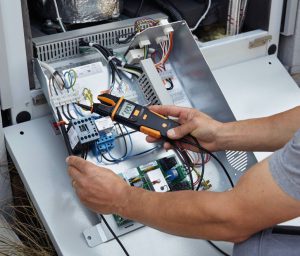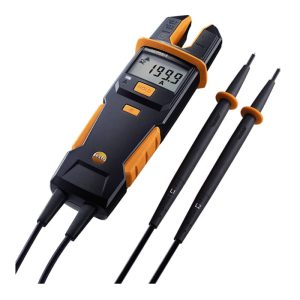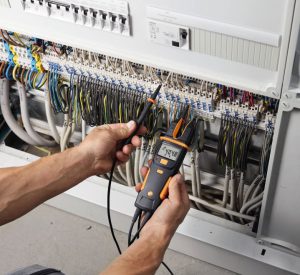The Testo 755-1 and Testo 755-2 may have caught your attention if you’re looking for a dependable and simple-to-use voltage detector for your electrical measurements.
These two well-liked current/voltage tester models are from the renowned measuring instrument maker Testo.
But how do these two models differ from one another, and which one is better for your requirements? In this post, we will contrast the key characteristics, benefits, and drawbacks of the testo 755-1 and the testo 755-2.
On the basis of our research and certain additional variables or considerations that may influence your decision, we will also provide you with our advice. You will know which voltage detector is better for you and why by the time this article is up.
We’ll contrast the two voltage detectors, the Testo 755-1 and Testo 755-2, in terms of their key attributes.
These features include automatic measurement parameter detection, voltage range, current range, resistance range, continuity testing, phase rotation testing, and single pole testing. They also include display, flashlight, and measurement category. Let’s take a closer look at each feature.
The maximum voltage that the voltage detector can safely and reliably measure is indicated by the voltage range feature. The voltage detector is more adaptable for a variety of applications the larger the voltage range.
The voltage range for the testo 755-1 is 6 to 600 V AC/DC, whereas the voltage range for the testo 755-2 is 6 to 1000 V AC/DC. This indicates that the testo 755-2 is more suitable for difficult operations and can measure greater voltages than the testo 755-1.
The greatest current that the voltage detector can safely and correctly measure is indicated by the current range feature. The voltage detector is more potent for various applications the larger the current range.
The current range of the Testo 755-1 and Testo 755-2 is 0.1 to 200 A AC. This indicates that both models are appropriate for the majority of frequent activities and can monitor high currents.
The maximum resistance that the voltage detector can safely and reliably measure is indicated by the resistance range feature.
The voltage detector is more sensitive for various applications the higher the resistance range. The resistance range of the testo 755-1 and testo 755-2 is 1 to 100 k. This indicates that both models are appropriate for the majority of tasks and can assess both low and high resistances.
Testing for continuity: This function lets you know whether the voltage detector can determine whether two points have an ongoing electrical connection. For troubleshooting or checking wiring or circuits, this is helpful.
This feature allows continuity testing to be done with an audible indication on the Testo 755-1 and Testo 755-2.
Phase rotation testing: The voltage detector’s ability to determine whether the phases of a three-phase system are in the right order is indicated by this feature. This helps to guarantee the correct operation and security of motors or generators.
The testo 755-2 has this feature and can do phase rotation testing with a motor rotation indication, whereas the testo 755-1 does not.
Testing for single pole phase shows whether the voltage detector can determine whether a voltage is present in a single wire or not.
For locating live wires or testing switches or outlets, this is helpful. The testo 755-2 has this functionality and can perform single pole phase testing with an audible indicator, whereas the testo 755-1 does not.
Measurement category: The protection level provided by the voltage detector against transient overvoltages that may occur in electrical systems is indicated by this characteristic.
The voltage detector is more reliable and secure for various applications the higher the measurement category. The measurement categories for the Testo 755-1 and the Testo 755-2 are CAT IV 600 V and CAT III 1000 V, respectively.
This indicates that both models are suited for use in industrial settings and built to endure high-energy transients.
Display: This element describes how simple it is to read and comprehend the measurement results displayed on the voltage detector’s screen. The voltage detector is more user-friendly for many applications the larger and clearer the display.
The one-line LCD displays of the Testo 755-1 and Testo 755-2 both have a backlighting feature. This indicates that both models can display precise readings in a range of lighting conditions.
Whether or not the voltage detector has a built-in flashlight is indicated by this characteristic. Working in dimly light or gloomy environments can benefit from this. Both the Testo 755-1 and the Testo 755-2 contain this function as well as an integrated torch for lighting the measuring spot.
Automatic measurement parameter detection: The voltage detector’s ability to automatically identify the proper parameters and test range is shown by this characteristic.
This helps to maximize accuracy and save time. This feature allows the testo 755-1 and testo 755-2 to automatically recognize testing that is in progress and choose the appropriate meter configuration.
Table of Contents
ToggleThe key characteristics of the two models are listed in the following table:
Feature voltage ranges of testo 755-1 and testo 755-2 are 6 to 600 V AC/DC.6–1000 V AC/DC
range of AC current, 0.1 to 200 A0.1 to 200 A AC
Resistance range: 1 to 100 kilo-ohms
Testing for continuity
Testing the phase rotation No Yes
test for a single pole phase No
measurements type The CAT IV 600 V and CAT III 1000 V classifications
Display LCD with one line and backlight LCD with one line and backlight
Flashlight Yes Yes
Automatic parameter detection for measurements Yes Yes
The table shows that while the testo 755-1 and the testo 755-2 share many characteristics, they also differ in a few ways that could influence your decision based on your needs and preferences. We will go through each model’s benefits and how you may use them to your advantage in the following part.
Advantages:
In this section, we’ll discuss how each model’s flaws and restrictions may effect your performance or convenience. We will concentrate on the flaws or deficiencies in each model and discuss how they might be problematic or challenging in certain circumstances.
Testo 755-1: For various jobs, the testo 755-1 is less adaptable and powerful than the testo 755-2 due to a few drawbacks. Among these drawbacks are:
Its narrower voltage range of the testo 755-2 prevents it from accurately and securely measuring higher voltages. When testing industrial machinery, power lines, or other high-voltage devices, this could be a problem.
It cannot determine whether the phases of a three-phase system are in the proper order since it lacks a phase rotation testing feature. This can make it difficult to guarantee the proper performance and safety of motors or generators.
It is unable to test for the presence of a voltage in a single wire with an aural indication since it lacks a single pole phase testing function. When trying to locate live wires or test switches or outlets, this can be an issue.
Compared to the testo 755-2, it has a lower measurement category, making it less reliable and secure for various applications. It might not be able to tolerate high-energy transients and might not be appropriate for use in industrial settings.
Testo 755-2: For particular activities, the Testo 755-2 is more expensive and complex than the Testo 755-1 due to a few drawbacks. Among these drawbacks are:
Since it can measure voltages over a wider range than the Testo 755-1, it is less sensitive and precise when measuring low voltages. This may be a challenge when testing solar panels, batteries, or other low-voltage equipment.
Given that it costs more than the testo 755-1, some users may find it to be less accessible and cost-effective. Saving money and obtaining a good value for your money may be difficult in this situation.
It has more functions than the testo 755-1, making it more complicated and challenging for certain users to use. This may make it difficult to learn how to use it effectively.
Both models, as you can see from this section, have drawbacks that, depending on the needs and preferences of the user, may discourage some from using them. We will describe the key findings of our comparison and provide our recommendation based on our analysis in the following section.
Conclusion: In this section, we’ll list the key takeaways from our comparison and offer a suggestion based on our research.
We will also discuss any other elements or things to think about that might influence your choice.
Testo 755-1 and Testo 755-2, two voltage detectors, have been compared. We have examined their key characteristics, positives, and negatives.
We have discovered that both versions share numerous characteristics, including automatic measurement parameter identification, continuity testing, current range, resistance range, display, and lighting. Nevertheless, they also differ in a few ways that, depending on your needs and preferences, may influence your choice.
The testo 755-1 features a reduced price, a single lead voltage test with auditory indication, a 3-phase sequence check with motor rotation indication, and a smaller voltage range.
These characteristics make it a dependable and practical voltage detector for the majority of everyday operations. It is unable to test single pole phase, check phase rotation, or monitor greater voltages, though. Furthermore, it falls into a lower measurement category and might not be appropriate for use in industrial settings.
The testo 755-2 includes a greater voltage range, single pole phase testing, phase rotation testing, and higher measurement category features. These characteristics make it a flexible and potent voltage detector for harder tasks. Although it costs more, is more complicated to use, and cannot accurately measure low voltages.
Based on our comparison, we advise consumers who require a straightforward and reasonably priced voltage tester for the majority of routine jobs to use the testo 755-2.
For consumers who require a reliable and adaptable voltage detector for more difficult jobs, we suggest the testo 755-2.
However, other factors or considerations, such as availability, warranty, customer service, personal preference, etc., may also influence your decision. Therefore, before making a final choice, we advise you to conduct your own research and compare the two models.
The article has come to an end now. We sincerely hope you found it instructive and useful. Enjoy your day and thanks for reading.




